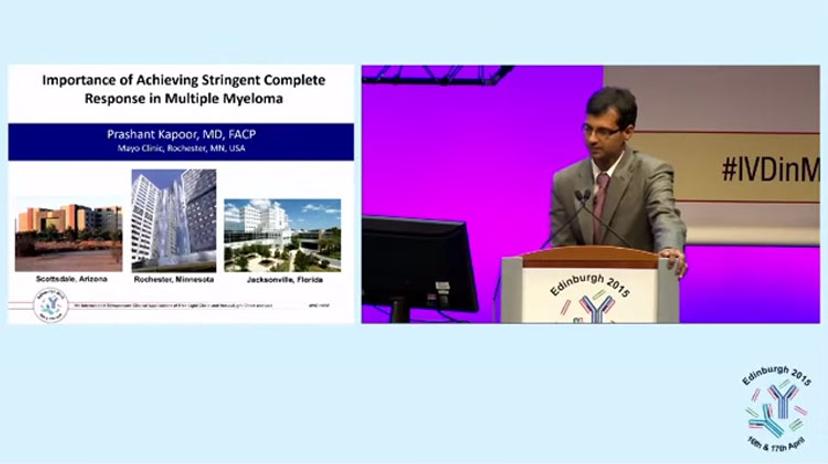The Importance of Stringent Complete Response (sCR) in Multiple Myeloma
Dr Prashant Kapoor addresses the delegation at the 7th International Binding Site Symposium
7 Oct 2016

Dr Prashant Kapoor delivered a session on sCR at the Binding Site symposium held recently in Edinburgh, UK
New drug developments and improved screening have led to an increase in the number of multiple myeloma patients achieving complete response (CR) after undergoing autologous stem-cell transplantation. The International Myeloma Working Group (IMWG) has developed a set of criteria to define different levels of response, including partial response (PR), CR and stringent CR (sCR).
Definition of sCR
sCR is defined by the IMWG as involving "those patients achieving complete response, who also display a normalized free-light chain ratio in the absence of monoclonal bone marrow plasma cells when assessed by immunohistochemistry or immunofluorescence."
In his presentation, Dr Kapoor, of the Mayo Clinic, explained that sCR is a level of response that is on the path to a cure. The iceberg shown in the figure below highlights that sCR is one step further along the pathway than CR.

sCR is a level of CR that is on the path to a patient being cured of multiple myeloma
Depth of response
Determining the patient’s depth of response is important. Dr Kapoor showed the conference delegates several graphs demonstrating that patients with CR have a better survival rate than patients with PR. When this is further categorized, of those patients with CR, those with sCR have a significantly better survival rate again than patients with CR or near CR (nCR).
Dr Prashant Kapoor Prashant Kapoor, MD, FACP, is an Assistant Professor of Medicine and Oncology, and a Senior Associate Consultant in the Division of Hematology at Mayo Clinical, Rochester.

This graph shows the significantly improved survival rates of patients with sCR
Dr Kapoor also showed statistics demonstrating that patients achieving sustained sCR for six months post transplant had a better overall survival rate than those patients who had lost their sCR status within six months.
Dr Kapoor explained how recent studies have shown that in patients with a PR, those with a normalized ratio also had a better survival time. He stressed that normalized FLC ratio is an important factor for the improved prognosis at all levels of autologous stem-cell transplant responses, not just sCR.
Based on the improved survival noted for patients achieving sCR, as compared to CR, Dr Kapoor stated that all myeloma trials reporting response rates should identify patients achieving sCR and CR separately.

Graph showing the survival rates of patients in PR with a normal and abnormal FLC ratio
In summary, sCR is becoming an increasingly attainable goal for myeloma patients. sCR requires a patient to have a normalized Freelite ratio. Evidence shows that sustained sCR is associated with improved long-term outcome, and while sCR does not mean a patient is cured, it does mark profound tumor reduction.
View Dr Kapoor's full presentation here.
